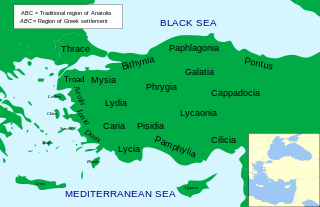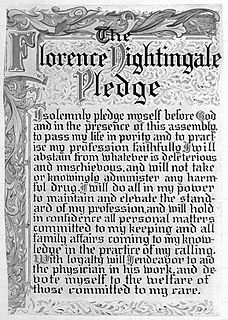
Timothy or Timothy of Ephesus was an early Christian evangelist and the first Christian bishop of Ephesus, who tradition relates died around the year AD 97.
Lystra was a city in central Anatolia, now part of present-day Turkey. It is mentioned six times in the New Testament. Lystra was visited several times by Paul the Apostle, along with Barnabas or Silas. There Paul met a young disciple, Timothy. Lystra was included by various authors in ancient Lycaonia, Isauria, or Galatia.

Lycaonia was a large region in the interior of Asia Minor, north of the Taurus Mountains. It was bounded on the east by Cappadocia, on the north by Galatia, on the west by Phrygia and Pisidia, while to the south it extended to the chain of Mount Taurus, where it bordered on the country popularly called in earlier times Cilicia and in the Byzantine period Isauria; but its boundaries varied greatly at different times. The name is not found in Herodotus, but Lycaonia is mentioned by Xenophon as traversed by Cyrus the Younger on his march through Asia. That author describes Iconium as the last city of Phrygia; and in Acts 14:6 Paul, after leaving Iconium, crossed the frontier and came to Lystra in Lycaonia. Ptolemy, on the other hand, includes Lycaonia as a part of the province of Cappadocia, with which it was associated by the Romans for administrative purposes; but the two countries are clearly distinguished both by Strabo and Xenophon and by authorities generally.
Robin Moore Hardy is the author of more than twenty published books and several unpublished manuscripts. She currently resides in North Texas. Her first novel, Chataine's Guardian, was the runner-up for the Gold Medallion Book Award in 1985.

The Nightingale Pledge, named in honour of Florence Nightingale, is a modified version of the Hippocratic Oath. Lystra Gretter and a Committee for the Farrand Training School Grace for Nurses in Detroit, Michigan created the pledge in 1893. Gretter, inspired by the work of Nightingale, the founder of modern nursing, credited the pledge to the work of her committee, but was herself considered "the moving spirit behind the idea" for the pledge.

Lystra Eggert was born in September 1858 in Bayfield, Ontario. She attended grade school in the Bayfield area until 1866 when her family moved to Greensboro, North Carolina. It was here that Lystra began attending private schools. When she was finished with school, at the age of 19, she married a man by the name of John Birney Gretter, where she then took the name, Lystra Gretter. Her husband, John, was approximately twenty six years older and a veteran of the Confederate Army led by Robert E. Lee. In the year 1881, Lystra and John welcomed their first and only daughter, Mary.

The family Fulgoridae is a large group of hemipteran insects, especially abundant and diverse in the tropics, containing over 125 genera worldwide. They are mostly of moderate to large size, many with a superficial resemblance to Lepidoptera due to their brilliant and varied coloration. Various genera and species are sometimes referred to as lanternflies or lanthorn flies, though they do not emit light.

Jane Lampton "Jean" Clemens was the daughter of Samuel Langhorne Clemens and Olivia Langdon Clemens. She drowned in a bathtub at Samuel's home on Christmas Eve 1909, likely due to a seizure.

Saint Artemas of Lystra was a biblical figure. He is mentioned in Paul's Epistle to Titus.

Is Shakespeare Dead? is a short, semi-autobiographical work by American humorist Mark Twain. It explores the controversy over the authorship of the Shakespearean literary canon via satire, anecdote, and extensive quotation of contemporary authors on the subject.

Cyanopepla is a genus of moths in the subfamily Arctiinae. The genus was erected by James Brackenridge Clemens in 1861.

Olivia Susan Clemens was the second child and eldest daughter of Samuel Clemens, who wrote under the pen name Mark Twain, and his wife Olivia Langdon Clemens. She inspired some of her father's works, at 13 wrote her own biography of him, which he later published in his autobiography, and acted as a literary critic. Her father was heartbroken when she died of spinal meningitis at age 24.
Netball in Trinidad and Tobago is a popular sport.
Cyanopepla lystra is a moth of the subfamily Arctiinae. It was described by Herbert Druce in 1896. It is found in Colombia.

Acts 14 is the fourteenth chapter of the Acts of the Apostles in the New Testament of the Christian Bible. It records the first missionary journey of Paul and Barnabas to Phrygia and Lycaonia. The book containing this chapter is anonymous but early Christian tradition uniformly affirmed that Luke composed this book as well as the Gospel of Luke.

According to the New Testament, Eunice was the mother of Timothy and influenced his faith in Christ. Born into the Jewish faith, she and her mother Lois accepted Christianity.
Artemas, Saint Artemas of Lystra, is a Christian biblical figure.

The subfamily Poiocerinae include Hemipteran insects in the family Fulgoridae, found especially in the tropics.

Lystra lanata is a planthopper species in the genus Lystra. Originally described by Carl Linnaeus by its basionym Cicada lanata.
Hatunsaray is a small village in Turkey located south-southeast of the ancient site of Lystra. A small museum within the village of Hatunsaray displays artifacts from ancient Lystra.













